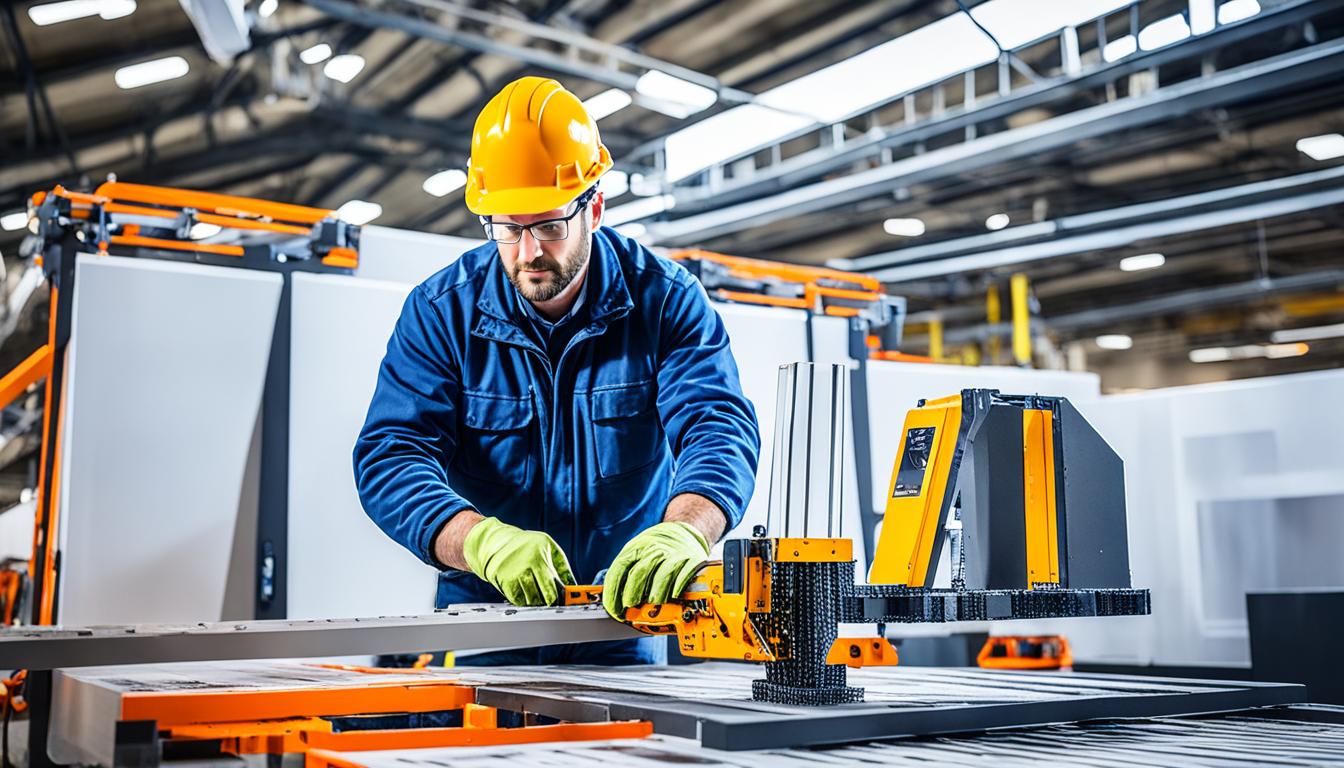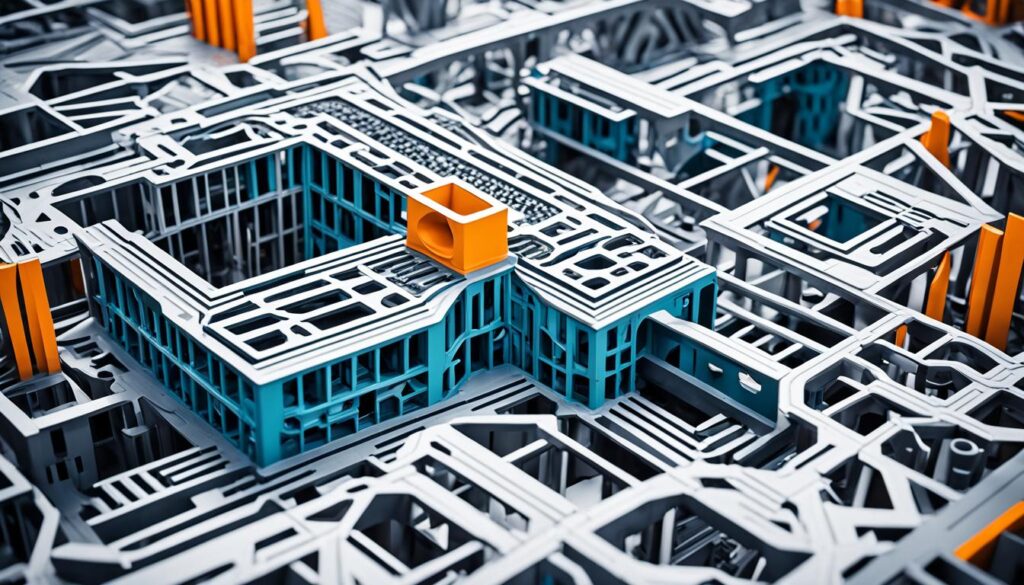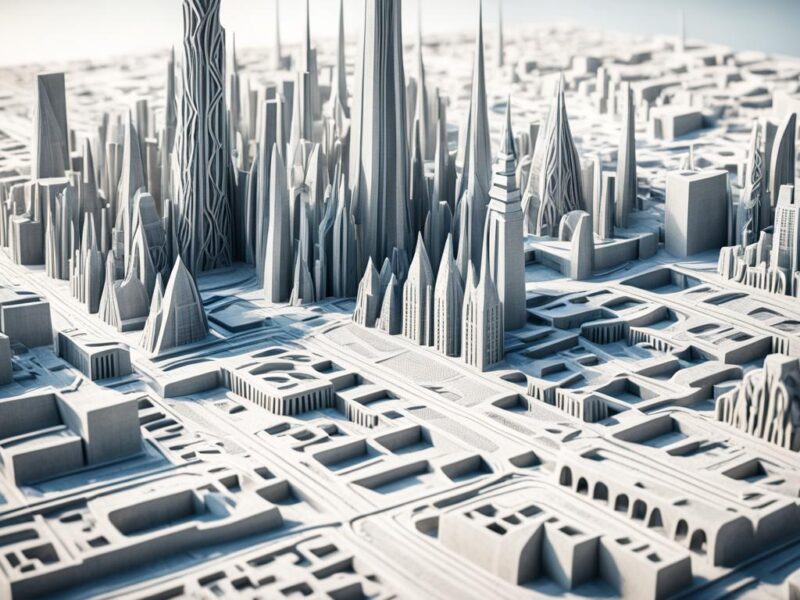
Exploring Additive Manufacturing in Construction
Did you know that additive manufacturing, also known as 3D printing, has the potential to revolutionize the construction industry? With its ability to create intricate and geometrically complex structures, 3D printed concrete offers a new frontier in sustainable building projects.
By leveraging additive construction techniques and advanced additive manufacturing technologies, construction professionals can reap the benefits of 3D printing in construction. Design freedom, reduced material waste, enhanced structural performance, and customization options are just a few advantages that make additive manufacturing a game-changer in the building industry.
But it doesn’t stop there. The sustainable advantages of 3D printed concrete go beyond aesthetics. With reduced carbon footprint, energy efficiency, and material optimization, additive manufacturing has the potential to transform the way we build.
Key Takeaways:
- Additive manufacturing, or 3D printing, is transforming the construction industry.
- 3D printed concrete offers design freedom, reduced waste, and enhanced structural performance.
- Sustainable advantages include reduced carbon footprint, energy efficiency, and material optimization.
- Applications of 3D printed concrete range from residential construction to infrastructure development.
- The future of sustainable construction lies in the continued innovation of additive manufacturing technology.
Unlocking the Sustainable Potential of 3D Printed Concrete in Building Projects
3D printed concrete, also known as additive manufacturing in construction, is a groundbreaking technology that allows for the layer-by-layer deposition of cementitious materials using computer-controlled systems. This innovative approach to construction offers numerous advantages and holds significant sustainable potential for building projects.
One of the key benefits of 3D printed concrete is its design freedom. The technology allows for the creation of intricate and complex structures that were previously challenging or impossible to build using traditional methods. This opens up exciting possibilities for architects and engineers to push the boundaries of design and create unique, eye-catching structures.
In addition to design freedom, 3D printed concrete reduces material waste and enhances structural performance. The precise layer-by-layer deposition of the concrete enables efficient use of materials, minimizing waste generation. This not only reduces costs but also promotes sustainability by optimizing resource utilization.
| Advantages of 3D Printed Concrete | Sustainable Potential |
|---|---|
| Design freedom | Reduced material waste |
| Enhanced structural performance | Promotes sustainability |
| Customization options | Optimized resource utilization |
Furthermore, 3D printed concrete has a significant positive impact on the carbon footprint of the construction industry. By minimizing material waste and optimizing material usage, this technology contributes to a more sustainable approach to construction. Additionally, the streamlined construction process and reduction in labor-intensive tasks lead to increased energy efficiency.
The applications of 3D printed concrete in building projects are vast and varied. From residential construction to large-scale infrastructure development, this technology has the potential to revolutionize the way we build. Sustainable renovations, architectural masterpieces, and infrastructure projects can all benefit from the advantages of 3D printed concrete.
To fully unlock the sustainable potential of 3D printed concrete, future advancements are crucial. Integration of recycled aggregates and eco-friendly additives can further enhance the sustainability of the construction industry. Advancements in on-site 3D printing and scalability for larger projects will also contribute to the widespread adoption of this technology.
Overall, 3D printed concrete offers a sustainable and innovative solution for building projects. By harnessing its potential, we can create structures that are not only visually stunning but also environmentally friendly.
Advancements in 3D Printing Technology for Constructing Concrete Structures
3D printing technology has brought significant advancements to the field of construction, revolutionizing traditional processes and opening up new possibilities for creating complex and customized concrete structures. Architects and engineers can now push the boundaries of innovation, thanks to the increased design freedom and complexity offered by these advancements.
One of the key benefits of 3D printing technology in construction is the cost and time savings it provides. By decreasing labor and material expenses and enhancing efficiency in construction timelines, 3D printing technology offers significant advantages in terms of both cost-effectiveness and project completion time.
Moreover, 3D printed concrete plays a crucial role in reducing material waste and minimizing environmental impact. Through optimized material usage and reduced energy consumption, 3D printing technology contributes to sustainable construction practices.
Real-world applications of 3D printing in construction span across various areas, including affordable housing solutions, infrastructure development, and sustainable renovations. The ability to create intricate and geometrically complex structures with precise accuracy has paved the way for innovative construction projects.
It is important to note that with the emergence of 3D printing technology, concerns about job loss have been mitigated. The introduction of new roles focused on operating and maintaining 3D printing technologies has created opportunities for skilled professionals in the construction industry.
As 3D printing technology continues to evolve, regulatory changes become essential to ensure safety guidelines and standards for its implementation in construction. This will allow for the seamless integration of 3D printing technology into existing construction practices, ensuring both efficiency and safety in the construction industry.
Key Takeaways
- Advancements in 3D printing technology have revolutionized construction processes.
- The technology offers increased design freedom and complexity for constructing concrete structures.
- Cost and time savings, as well as reduced material waste, are key benefits of 3D printing in construction.
- Real-world applications include affordable housing solutions, infrastructure development, and sustainable renovations.
- Regulatory changes are necessary to ensure safety guidelines and standards for 3D printing technology in construction.
| Advancements in 3D Printing Technology for Constructing Concrete Structures |
|---|
| Increased design freedom and complexity |
| Cost and time savings |
| Reduction of material waste |
| Sustainable construction practices |
| Real-world applications |
| Job opportunities in 3D printing technologies |
| Regulatory changes for safety guidelines and standards |
Overcoming Challenges in Implementing Additive Manufacturing
Implementing additive manufacturing in construction presents several technical challenges that need to be overcome for successful implementation. One of the primary challenges is ensuring the desired strength and durability of printed structures. As additive manufacturing techniques evolve, it’s crucial to refine the printing process and optimize material compositions to achieve optimal structural integrity.
Another challenge lies in regulatory and code compliance. Adapting existing regulations to accommodate additive manufacturing techniques may require revisions and updates to ensure safety and quality standards are met. This process requires collaboration between industry stakeholders, regulatory bodies, and standardization organizations to establish guidelines that address potential risks and concerns.
Construction professionals play a crucial role in the successful implementation of additive manufacturing. They need to adapt and receive training not only in operating the technology but also in understanding its limitations and potential applications. Education and upskilling programs can equip construction professionals with the knowledge and expertise to effectively utilize additive manufacturing technologies, leveraging their benefits to drive innovation and efficiency.
Ongoing research and development initiatives are crucial in overcoming technical challenges and further pushing the boundaries of what additive manufacturing can achieve in construction. Continuous improvements in printing techniques, material formulations, and automation processes enhance the potential of additive manufacturing and facilitate its widespread adoption in the industry. With a dedicated focus on addressing challenges and fostering innovation, additive manufacturing holds vast potential to revolutionize the construction industry.

Challenges in Implementing Additive Manufacturing
| Technical Challenges | Regulatory and Code Compliance | Adaptation and Training |
|---|---|---|
| Achieving desired strength and durability of printed structures | Adapting regulations to accommodate additive manufacturing techniques | Training construction professionals to effectively utilize additive manufacturing technologies |
| Continued research and development to address technical constraints | Collaboration between industry stakeholders, regulatory bodies, and standardization organizations | Education and upskilling programs for construction professionals |
| Ongoing adaptation to advancements in additive manufacturing technology |
Future Implications of Additive Manufacturing in Construction
Additive manufacturing, also known as 3D printing, has the potential to disrupt and transform the construction industry. The advancements in materials and technology have opened up new possibilities for innovation in additive manufacturing, paving the way for a future where highly customized structures can be created with ease.
One of the key future implications of additive manufacturing in construction is the increased efficiency it brings to the industry. With the ability to create complex structures layer by layer, construction projects can be executed with greater precision and speed. This not only reduces costs but also allows for faster project completion, meeting the ever-growing demands of the construction industry.
Another significant impact of additive manufacturing is the reduction in material waste. Traditional construction methods often result in substantial amounts of waste, but additive manufacturing techniques optimize material utilization, minimizing waste generation. By implementing 3D printing technology, the construction industry can move towards a more sustainable and environmentally friendly approach.
Additionally, additive manufacturing has the potential to improve construction safety and quality. With the ability to create intricate and geometrically complex structures, 3D printing technology can enhance the structural integrity of buildings. This ensures safer and more durable structures, reducing the risk of accidents and failures.
“Additive manufacturing has the potential to revolutionize the way we construct buildings. It allows us to push the boundaries of design and create structures that were previously unimaginable.” – [Expert Name], Construction Industry Professional
The long-term impact of additive manufacturing in construction will be far-reaching. As technology continues to advance, additive manufacturing will become more accessible, cost-effective, and efficient. This will drive further innovation in the industry and open up new possibilities for architectural design and construction methods.
In conclusion, additive manufacturing holds tremendous promise for the future of the construction industry. Its ability to increase efficiency, reduce material waste, and improve construction safety and quality will reshape the way buildings are constructed. With ongoing advancements in materials and technology, the potential for additive manufacturing in construction is truly transformative.
| Future Implications of Additive Manufacturing in Construction |
|---|
| Increased efficiency in construction projects |
| Reduction in material waste |
| Improvement in construction safety and quality |
| Possibility for highly customized structures |
Strategies for Integration of BIM and 3D Concrete Printing into Construction
Building Information Modeling (BIM) and 3D concrete printing are two revolutionary technologies that have the power to transform the construction industry. By integrating these technologies, construction professionals can unlock a world of possibilities in terms of collaboration, accuracy, and efficiency.
One of the key strategies for integration is the adoption of BIM as a comprehensive digital representation of the building project. BIM models provide a detailed and holistic view of the construction process, allowing stakeholders to collaborate effectively and make informed decisions. By leveraging BIM, architects, engineers, and contractors can streamline their workflows, reduce errors, and improve overall project efficiency.
Implementing 3D concrete printing requires careful preparation and coordination with BIM. First, BIM models need to be created, capturing all the necessary design elements and parameters. These models serve as the blueprint for the 3D printing process, enabling precise deposition of concrete layers.
Once the BIM models are ready, the next step is to formulate concrete mixes optimized for 3D printing. Different types of concrete formulations may be required based on the specific project requirements and structural needs. Admixtures and reinforcements can also be incorporated to enhance the strength and durability of the 3D-printed concrete structures.
Calibrating the printers is another critical aspect of implementation. The print settings need to be fine-tuned to ensure accurate deposition of the concrete layers, achieving the desired geometries and structural integrity. The calibration process involves iterative adjustments and testing to optimize the printing parameters.
Training and adaptation of construction professionals are essential for successful implementation. Workers need to be familiarized with the principles and techniques of 3D concrete printing, as well as the operation and maintenance of the printing equipment. Upskilling programs and training workshops can equip construction professionals with the necessary knowledge and skills to leverage this transformative technology effectively.
Collaboration between industry professionals, regulators, and standardization organizations is also crucial for the widespread adoption of BIM and 3D concrete printing in construction. Addressing regulatory and compliance challenges requires a collaborative effort to establish guidelines, standards, and safety protocols that align with the unique requirements of these technologies.
In conclusion, the integration of BIM and 3D concrete printing holds immense potential for the construction industry. By adopting BIM and implementing 3D concrete printing strategies, construction professionals can drive efficiency, accuracy, and sustainability in building projects. Collaboration, training, and regulatory support are essential to overcome challenges and unlock the full benefits of these transformative technologies.
Conclusion
As the construction industry continues to evolve, additive manufacturing, or 3D printing, has emerged as a game-changing technology. This innovative approach to construction offers numerous benefits, including reduced material waste, enhanced design freedom, and increased sustainability. 3D printed concrete structures can be customized with intricate details and geometric complexity, pushing the boundaries of architectural innovation.
The integration of 3D printed concrete into building projects holds immense potential for sustainable construction. The technology enables optimized resource utilization, reducing the carbon footprint and promoting energy efficiency. From residential construction to large-scale infrastructure development, the applications of 3D printed concrete are diverse and far-reaching.
Although challenges in implementation and regulatory compliance exist, ongoing advancements in 3D printing technology and the training of construction professionals are addressing these hurdles. The future implications of additive manufacturing in construction are promising, with the potential to revolutionize the industry, increase efficiency, and improve construction safety and quality. As the construction industry embraces this transformative technology, collaboration and adaptation will be key to unlocking its full potential.
FAQ
What is additive manufacturing in construction?
Additive manufacturing in construction, also known as 3D printing in construction, involves layer-by-layer deposition of cementitious materials using computer-controlled systems. It revolutionizes traditional construction processes, allowing for the creation of complex and customized concrete structures.
What are the benefits of 3D printing in construction?
3D printing in construction offers numerous benefits, including design freedom, reduced material waste, enhanced structural performance, and customization options. It also reduces the carbon footprint, promotes energy efficiency, streamlines the construction process, and reduces labor-intensive tasks.
What are the applications of 3D printed concrete in construction?
3D printed concrete has a wide range of applications, including residential construction, architectural masterpieces, infrastructure development, and sustainable renovations. It can be used to create affordable housing solutions, construct large-scale structures, and enhance the overall sustainability of building projects.
How does 3D printed concrete contribute to sustainable construction?
3D printed concrete contributes to sustainable construction by reducing the carbon footprint through optimized material usage and minimized waste generation. It also promotes energy efficiency by streamlining the construction process and reducing labor-intensive tasks. The technology encourages a more sustainable approach to resource utilization through material optimization and waste reduction.
What are the challenges in implementing additive manufacturing in construction?
Implementing additive manufacturing in construction comes with technical challenges, such as achieving desired strength and durability of printed structures. Regulatory and code compliance issues may arise in adapting regulations to accommodate additive manufacturing techniques. Construction professionals also need to adapt and receive training to effectively utilize additive manufacturing technologies.
What is the future of additive manufacturing in construction?
Additive manufacturing has the potential to disrupt and transform the construction industry. Advancements in materials and technology will continue to drive innovation in additive manufacturing, opening up new architectural and design possibilities. The long-term impact includes increased efficiency, reduced material waste, and improved construction safety and quality.
How can BIM and 3D concrete printing be integrated into construction?
Integration of BIM (Building Information Modeling) and 3D concrete printing can be achieved by adopting BIM for comprehensive digital representation and enhancing collaboration, accuracy, and efficiency. Implementing 3D concrete printing involves preparing BIM models, formulating concrete mixes, calibrating printers, and depositing layers of concrete. The use of reinforcements and admixtures enhances the strength and durability of 3D-printed concrete structures.
What are the strategies for successful integration of additive manufacturing in construction?
Successful integration of additive manufacturing in construction requires collaboration between industry professionals, regulators, and standardization organizations. It is essential to address regulatory and compliance challenges and ensure safety guidelines and standards for 3D printing technology. Ongoing research and development are addressing technical challenges and pushing the boundaries of what additive manufacturing can achieve.
Source Links
- https://utilitiesone.com/exploring-the-potential-of-3d-printing-in-concrete-construction
- https://economictimes.com/news/et-explains/et-explainer-building-the-future-exploring-3d-printing-in-construction/articleshow/106534175.cms
- https://www.linkedin.com/pulse/bim-3d-concrete-printing-exploring-additive-manufacturing







